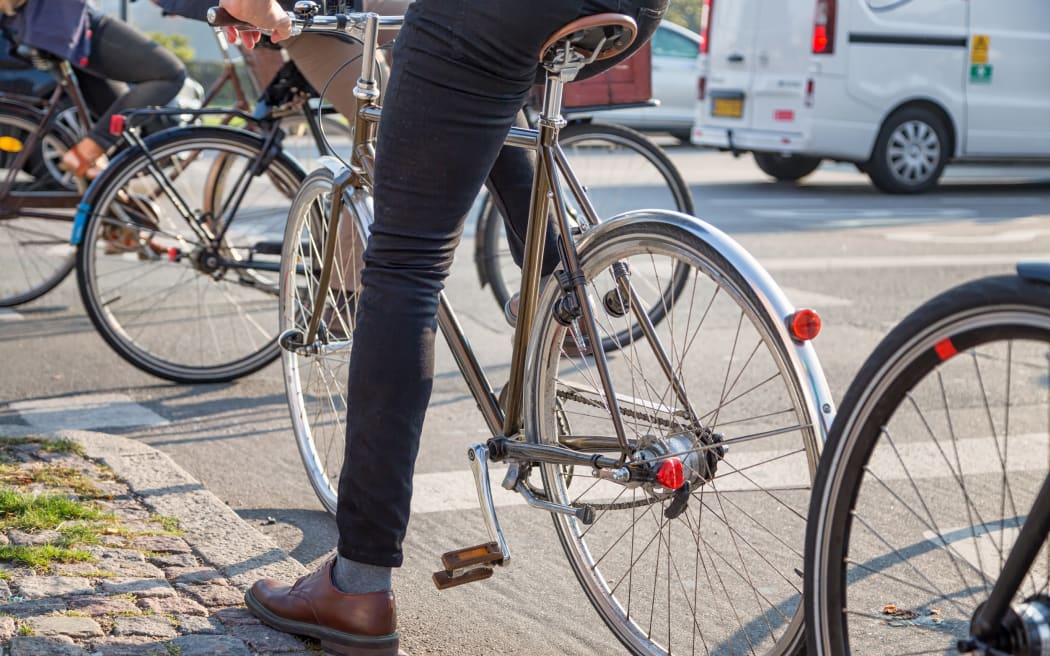
More than 700 of the 1947 crashes in Auckland involving a car and a pedestrian, cyclist or person on a scooter since 2021 have been in West Auckland. File photo. Photo: 123rf
West Auckland is the most dangerous part of the city for cyclists and pedestrians, according to figures obtained under the Official Information Act.
Data from NZTA Waka Kotahi shows more than a third of crashes in the city in the past three years involving pedestrians, cyclists and people on scooters have been in the Western suburbs.
Residents say they don't feel safe sending kids to school on bikes - and even seasoned cyclists are considering giving up their bikes because of the danger.
Dr Sarah Paterson-Hamlin cycles in Avondale with her two young children on a cargo bike.
"It's terrifying. I do it as advocacy, really - I think if I was weighing up my choices based on safety, I just wouldn't do it," she said.
During the school holidays, her husband tried cycling with their 4-year-old along the footpath to pre-school, and on the first ride, he was hit by a reversing car.
"Somebody came out of a private road driveway quite a lot faster than they should have been. They didn't see my son at all," she said.
"They slowed down a bit, but not in time, and my 4-year-old was hit by the car, and his arm went under the wheel. We were incredibly lucky - it seems that it just pinched his skin, nothing was broken, but my husband was obviously incredibly distraught."
Paterson-Hamlin said she could not see how cycling to school could be safe for her children without significant investment in separated cycleways.
"My initial reaction was to say, after years of advocacy, we're selling all the bikes - what can we do to make this safe?"
"The aspirations we had for them to be cycling by themselves when they're a little bit older, to school and back - unless there's really significant investment in protected cycleways and Te Whau Pathway, I just cant see it happening until year 13 pretty much."
Crashes in the west
The data from Waka Kotahi showed there had been 1947 crashes in Auckland involving a car and a pedestrian, cyclist or person on a scooter since 2021.
And more than 700 of those crashes happened in West Auckland - the second-biggest hotspot is South Auckland, with 398 crashes.
Most of those accidents resulted in injury - there were 1861 injuries recorded from crashes involving pedestrian, cyclists, and people on scooters.
Sam Finnemore cycles from Glen Eden into the central city for work, and around wider West Auckland. He said while there were some good off-road paths, he also had to use high-traffic roads and that was a problem.
"I try to avoid them, wherever I can, I mostly try and cross them and get to paths and use local roads where I can to get to those other connectors, but yeah, it's dicey."
He was not blaming dangerous drivers for the conditions - he said it was members of the community that were all under pressure causing danger.
"West Auckland has a bit of a petrol head reputation, but I think it's stressed-out people that are trying to driving to work or do kindy school drop offs that almost more of a problem."
Other than the Avondale to New Lynn shared path, Finnemore said there were few separated areas for cyclists and pedestrians, and that put people off cycling.
"I think safety is probably quite a big barrier for a lot of people, particularly people maybe with children as well too," he said.
"I think really what the area needs, as much as anything else, is protected lanes on those major roads, which are the places where people actually want to go and some safe local routes, so people can actually get around in their own neighbourhoods and go to school and go to the shops."
'No death or serious injury on the road is acceptable'
Auckland Transport head of active modes Adrian Lord said it did what it could to prevent accidents.
"No death or serious injury on the road is acceptable. And we know for people walking and cycling, they make up about fifty percent of deaths and serious injuries in Auckland."
Lord said there was a safety scheme in school areas in New Lynn and Kelston, which slowed drivers down to prevent injury to other road users.
Separated cycle lanes will be built in inner-west areas, such as in Point Chevalier and Great North Road, over the next two years, but questions remain over how much they may be delayed.
In New Lynn, there is ring-fenced council money for cycle connections, but with a lower-than-expected government contribution, deadlines may be pushed out.
"We're going as fast as we can in the sort, funding environment, we are in.
"All of those projects will proceed... the ones after that are the ones where we may be more at risk, because we don't yet know how much money we will get in the national settlement and also in the local share through the long-term council plan."
Lord said Auckland Transport had long-term plans for projects for other outer-west suburbs, such as Lincoln Road in Henderson, but funding for them had not yet been approved.

